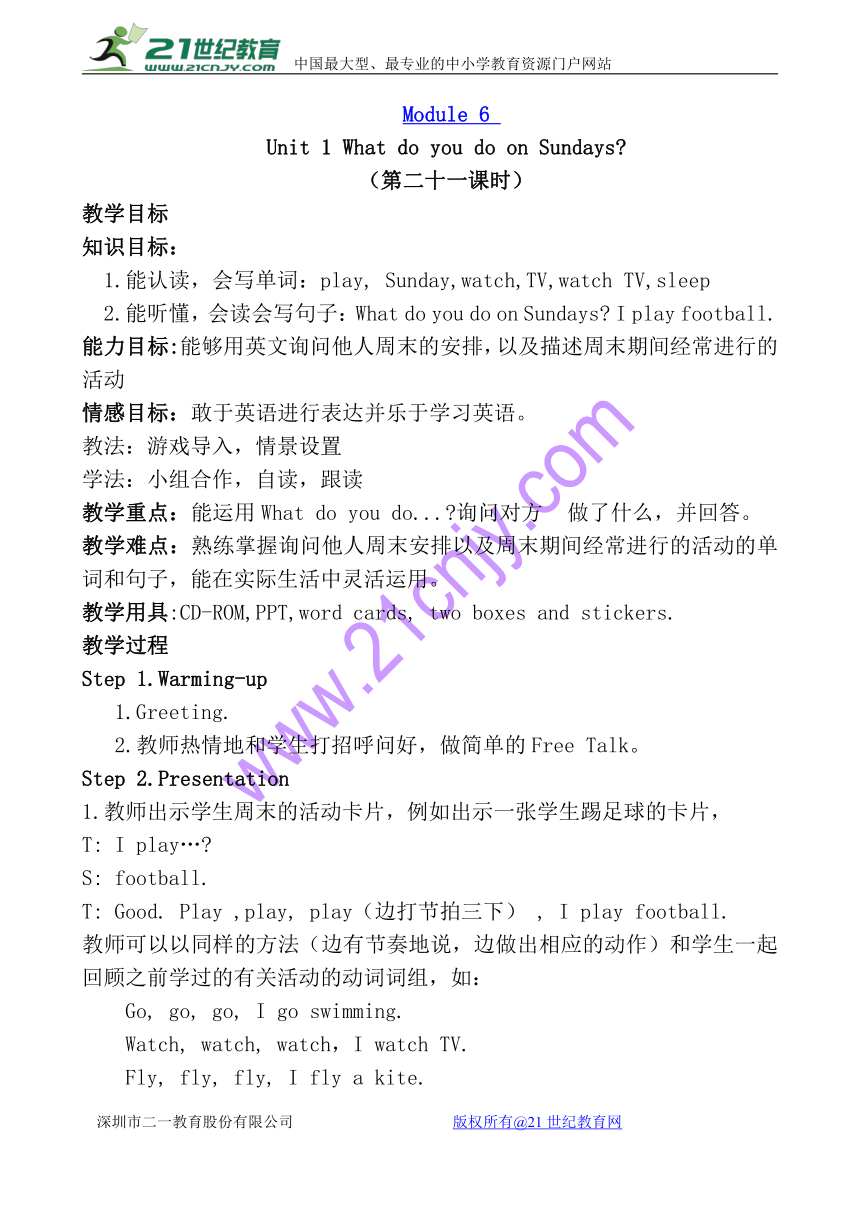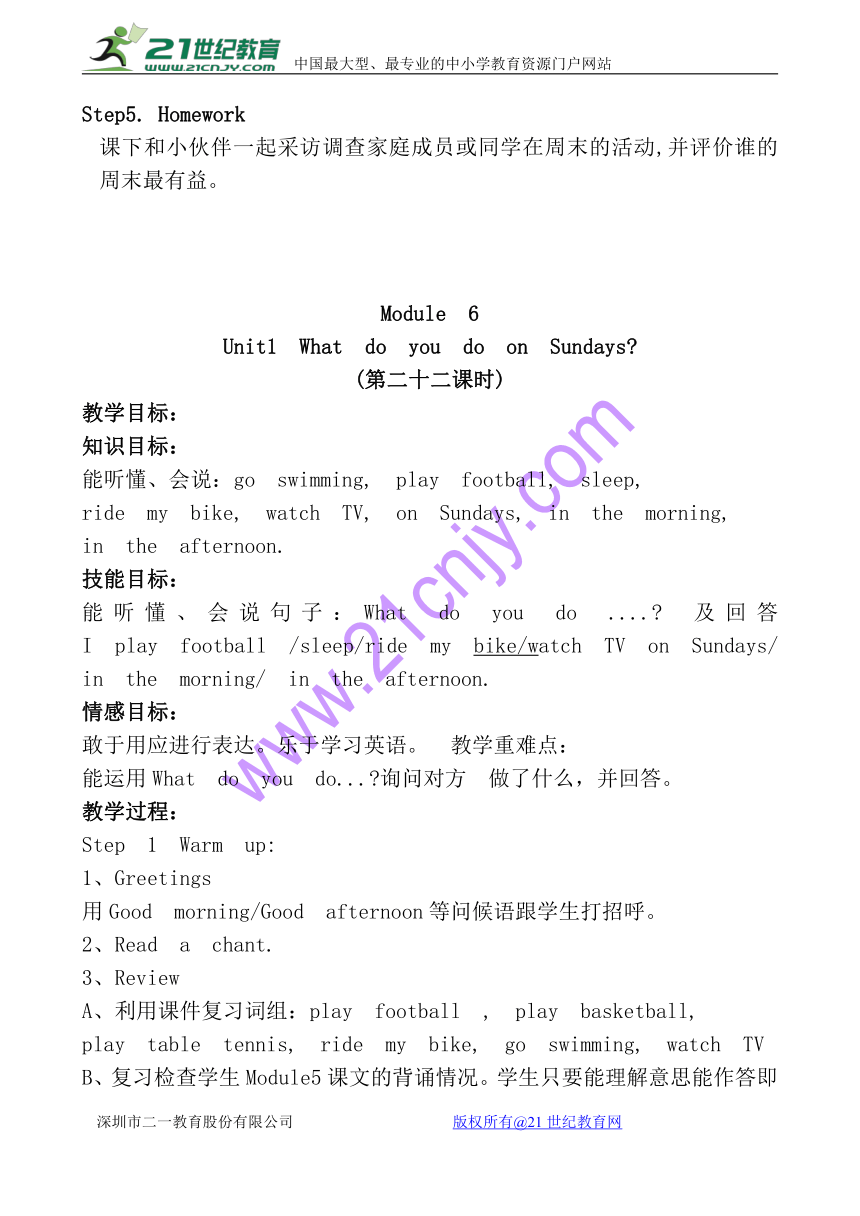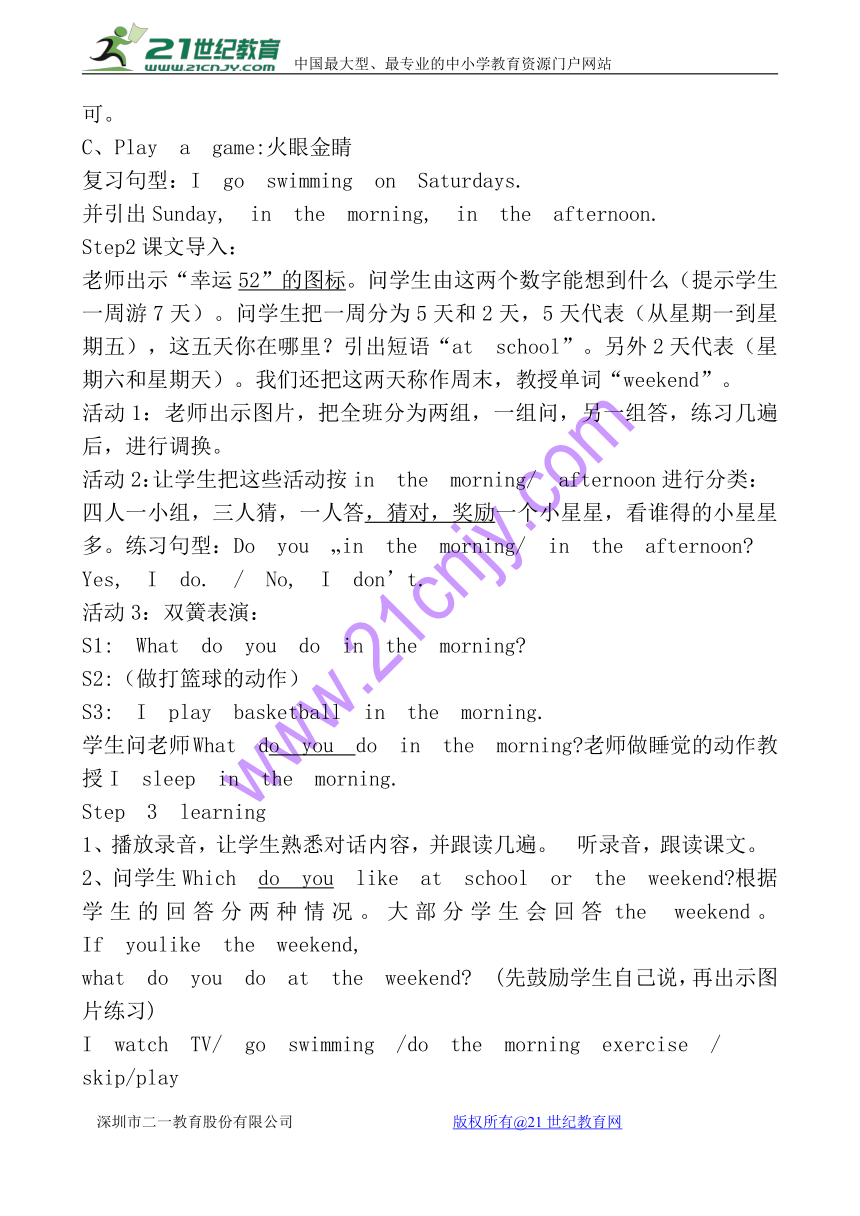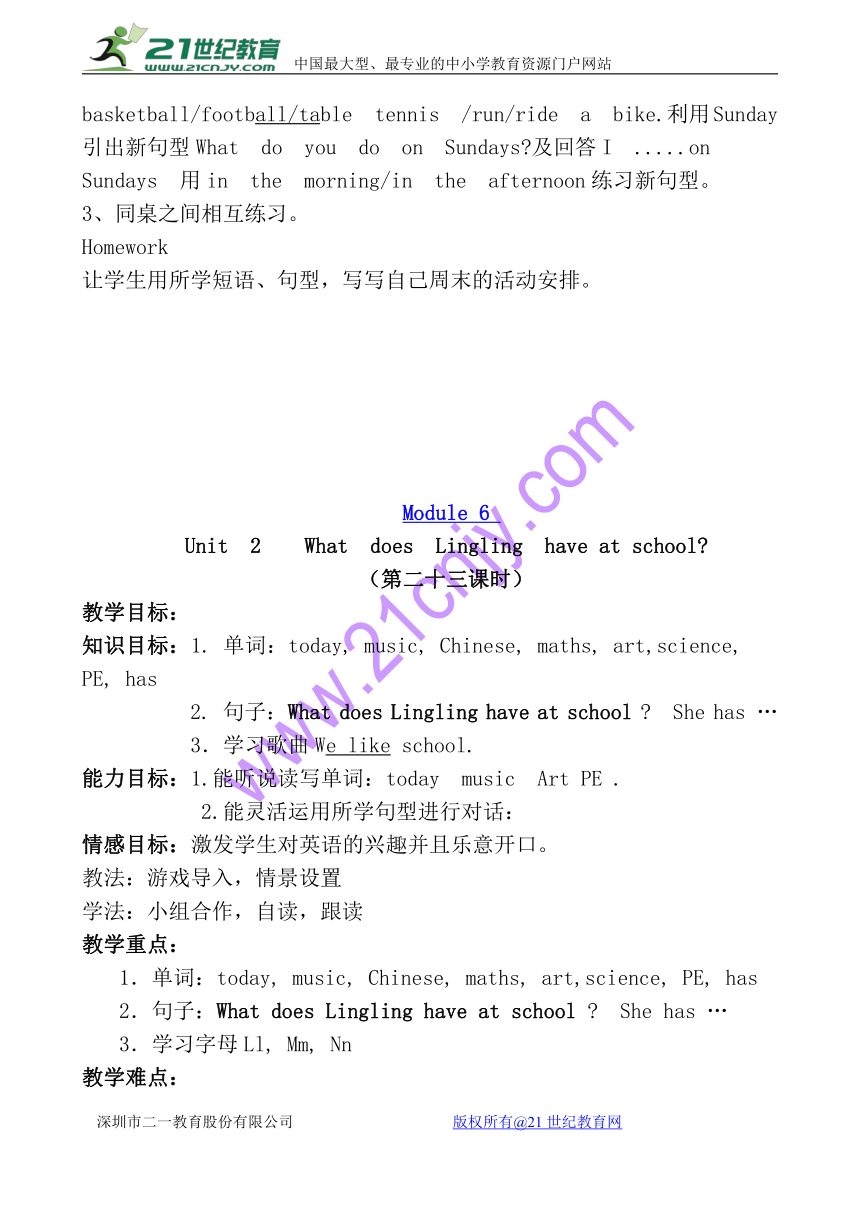外研版(三年级起点)小学英语三年级下册 Module 6-Module 10 教案
文档属性
| 名称 | 外研版(三年级起点)小学英语三年级下册 Module 6-Module 10 教案 |  | |
| 格式 | zip | ||
| 文件大小 | 182.8KB | ||
| 资源类型 | 教案 | ||
| 版本资源 | 外研版(三年级起点) | ||
| 科目 | 英语 | ||
| 更新时间 | 2018-01-07 08:12:18 | ||
图片预览





文档简介
Module 6 Unit 1 What do you do on Sundays? (第二十一课时) 教学目标 知识目标: 1.能认读,会写单词:play, Sunday,watch,TV,watch TV,sleep 2.能听懂,会读会写句子:What do you do on Sundays? I play football. 能力目标:能够用英文询问他人周末的安排,以及描述周末期间经常进行的活动 情感目标:敢于英语进行表达并乐于学习英语。 教法:游戏导入,情景设置 学法:小组合作,自读,跟读 教学重点:能运用What do you do...?询问对方 做了什么,并回答。 教学难点:熟练掌握询问他人周末安排以及周末期间经常进行的活动的单词和句子,能在实际生活中灵活运用。 教学用具:CD-ROM,PPT,word cards, two boxes and stickers. 教学过程 Step 1.Warming-up 1.Greeting. 2.教师热情地和学生打招呼问好,做简单的Free Talk。 Step 2.Presentation 1.教师出示学生周末的活动卡片,例如出示一张学生踢足球的卡片, T: I play…? S: football. T: Good. Play ,play, play(边打节拍三下) , I play football. 教师可以以同样的方法(边有节奏地说,边做出相应的动作)和学生一起回顾之前学过的有关活动的动词词组,如: Go, go, go, I go swimming. Watch, watch, watch,I watch TV.? Fly, fly, fly, I fly a kite. Dance, dance, dance, I dance, I dance.? Run, run, run, I run, I run. 2.教师对学生刚才的表现给以积极的肯定,并询问学生 T: Do you know what Daming and Sam do at the weekend? T: Do Daming and Sam go swimming / play basketball / play ping pong? 呈现教学挂图,播放录音,让学生认真观看挂图,带着老师刚才提出的问题静静地听录音。 3.教师再放一遍录音,让学生边听边看书,同时用比勾画出课文中的生词,然后根据上下文,和小组同学一起猜猜每个生词的意思。 4.之后教师归纳讲授新单词,请学生模仿跟读。可以通过多种灵活的练习方式,帮助学生巩固所学新单词。 5.老师认为学生理解和掌握了生词之后,再放录音,每句后停顿,学生跟读. 6.教师让学生分成小组进行课本剧表演,最后鼓励学生到台前汇报演出,对踊跃参与和表现优秀的同学要发送小礼物表示奖励。 Step3.Practice 教师和学生一起做游戏“趣味组句子” 教师准备两个盒子,一个盒子里装有表示活动的卡片,如踢足球,看电视,游泳等,另一个盒子里装有表示活动地点的卡片,如家,公园等。请两名学生到讲台前来,这时全班学生问:“What do you do at the weekend?”其中一名学生从盒子里抽出一张卡片,看图回答问题。如果他抽出的是一张踢足球的卡片,则回答:“I play football.”全班同学继续问:“Where do you play football?”于是另一名学生从第二个盒子里抽出一张卡片,看图回答问题。如果图片上画的是公园,则回答:“In the park.”接下来让全班学生将他们的回答连成一句话并读出来:“I play football in the park.”并请这两位同学一起表演出在公园里踢足球的动作。 Step4.Summary T:Let’s review what we have learned today. Step5. Homework 课下和小伙伴一起采访调查家庭成员或同学在周末的活动,并评价谁的周末最有益。 Module?6 Unit1?What?do?you?do?on?Sundays? (第二十二课时) 教学目标:? 知识目标:? 能听懂、会说:go?swimming,?play?football,?sleep,? ride?my?bike,?watch?TV,?on?Sundays,?in?the?morning,? in?the?afternoon.? 技能目标:? 能听懂、会说句子:What?do?you?do?....??及回答I?play?football?/sleep/ride?my?bike/watch?TV?on?Sundays/in?the?morning/?in?the?afternoon.? 情感目标:? 敢于用应进行表达。乐于学习英语。?教学重难点:? 能运用What?do?you?do...?询问对方?做了什么,并回答。 教学过程:? Step?1?Warm?up:? 1、Greetings? 用Good?morning/Good?afternoon等问候语跟学生打招呼。? 2、Read?a?chant.? Review? 利用课件复习词组:play?football?,?play?basketball,? play?table?tennis,?ride?my?bike,?go?swimming,?watch?TV B、复习检查学生Module5课文的背诵情况。学生只要能理解意思能作答即可。? C、Play?a?game:火眼金睛? 复习句型:I?go?swimming?on?Saturdays. 并引出Sunday,?in?the?morning,?in?the?afternoon.? Step2课文导入:? 老师出示“幸运52”的图标。问学生由这两个数字能想到什么(提示学生一周游7天)。问学生把一周分为5天和2天,5天代表(从星期一到星期五),这五天你在哪里?引出短语“at?school”。另外2天代表(星期六和星期天)。我们还把这两天称作周末,教授单词“weekend”。? 活动1:老师出示图片,把全班分为两组,一组问,另一组答,练习几遍后,进行调换。? 活动2:让学生把这些活动按in?the?morning/?afternoon进行分类:? 四人一小组,三人猜,一人答,猜对,奖励一个小星星,看谁得的小星星多。练习句型:Do?you??in?the?morning/?in?the?afternoon?? Yes,?I?do.?/?No,?I?don’t.? 活动3:双簧表演: S1:?What?do?you?do?in?the?morning?? S2:(做打篮球的动作) S3:?I?play?basketball?in?the?morning.? 学生问老师What?do?you?do?in?the?morning?老师做睡觉的动作教授I?sleep?in?the?morning.??21cnjy.com Step?3?learning? 1、播放录音,让学生熟悉对话内容,并跟读几遍。?听录音,跟读课文。? 2、问学生Which?do?you?like?at?school?or?the?weekend?根据学生的回答分两种情况。大部分学生会回答the?weekend。If?youlike?the?weekend,?www.21-cn-jy.com what?do?you?do?at?the?weekend??(先鼓励学生自己说,再出示图片练习)?21*cnjy*com I?watch?TV/?go?swimming?/do?the?morning?exercise?/ skip/play? basketball/football/table?tennis?/run/ride?a?bike.利用Sunday引出新句型What?do?you?do?on?Sundays?及回答I?.....on? Sundays?用in?the?morning/in?the?afternoon练习新句型。 3、同桌之间相互练习。? Homework? 让学生用所学短语、句型,写写自己周末的活动安排。? Module 6 Unit?2??What?does?Lingling?have at school? (第二十三课时) 教学目标: 知识目标:1. 单词:today, music, Chinese, maths, art,science, PE, has 2. 句子:What does Lingling have at school ? She has … 3.学习歌曲We like school.
能力目标:1.能听说读写单词:today?music?Art PE . 2.能灵活运用所学句型进行对话:
情感目标:激发学生对英语的兴趣并且乐意开口。21*cnjy*com 教法:游戏导入,情景设置 学法:小组合作,自读,跟读 教学重点: 1.单词:today, music, Chinese, maths, art,science, PE, has 2.句子:What does Lingling have at school ? She has … 3.学习字母Ll, Mm, Nn 教学难点: 主语第一人称及第三人称时,动词使用上发生的变化。 教学用具:PPT,CD-ROM, word cards and stickers. 教学过程:
Step 1 Warm up 1.?Greeting 2. T: Let’s sing? the?ABC song?! 3.?Revision
复习上一节课学过的单词。
T:? What?do?you?have?at?school?
Ss:? I?have?Music,?Art?and?PE.
T:? What?does?she?have?at?the?school?
引导学生说:
She? has? Music? Art? and? PE .
板书句子,以及教读句子。(全班读 , 小组读,个人读)???
T:OK.now,?allthe?studentread? these? sentences? together?very? good .??
T: First?group read?the?new??sentences.?? The?second , the third ,the fouth…
T:Who? wants? to read the? new? sentence ?? 4.?呈现新知识。
1)①教师出示 Ling Ling? 的图片边说:“
?I? gong? swimming? at? the? weekend .
?How? about? Lingling ??
?What? does? she? do? at? the? weekend ? ” 引导学生回答:“? She? _____? at? the? weekend .” Does? she? play? football? at? the? weekend ?? 帮助学生回答 :? —Yes , she? does? .?? —No,? she? doesn’t?
同时引导学生使用完整句子回答:She playsfootballat the weekend .
然后学生两人一组进行回答,操练句型。 ②.教师把挂图贴在黑板上,听录音机,跟读句子,跟读课文。 听一遍时老师提出问题: What? does? Lingling? have? at? school? today ??
What? does? she? do? at? the? weekend ??
请学生带着问题听录音,并且跟读。第三遍时,请同学边看边读画出新单词,试着找答案,最后让学生分角色表演课文。 .歌曲练习
① 先熟悉歌词的曲调,教师教读歌词。
② 教师教唱,学生跟唱。
③ 待学生熟悉后请学生边表演边唱。(全班唱,小组唱,个人唱)。?
4.?巩固 T:? Who can tell?me?:What do you want to do on weekends ? S1:? I? watch TV . S2:? I?play? basketball . S3:? I? play? the? computer . S4:? I?? do? my? homework . T:?? How?? wonderful?? your?? weekends !? What?? does?? Ling ling?? do? at? the? weekend ?
Ss:?She??plays?basketball/goes?swimming/watches? TV? and? sleeps. 5.?小结
1)全班齐读课文句子。 2)? sing? the? new?? song . 6.?作业
1) 唱本节课所学的歌曲给父母听。
2)熟读课文 Module?6 Unit?2?What?does?Lingling?have?at?school? (第二十四课时) 教学目标:? 知识目标: 单词:today,music,Chinese,Maths,art,science,PE,has?? 技能目标: 句子:What?does?Lingling?have?at?school????She?has? 学习歌曲We?like?school.? 情感目标:喜欢听说英语并敢于用英语表达。? 教学重点:? 单词:today,music,Chinese,Maths,art,science,PE,has? 句子:What?does?Lingling?have?at?school????She?has??? 学习字母L?l,?M?m,?N?n? 教学难点:?? 主语第一人称及第三人称时,动词使用上发生的变化。? 教学过程:? 1.热身复习? (1)英语展示角。学生可以上台表演英语节目,唱英语歌曲、讲英语故事、猜英语谜语、做英语游戏等,其他学生在台下积极回应,通过此环节让学生尽快融入学习英语的氛围中。老师要对学生的英语展示给予适当的评价,激发学生参与的兴趣。? (2)老师出示一本日历,打开日历到今天的日期,并强调突出星期几,随后翻阅日历到周日,在周日出现的时候老师用愉快的口吻说:“It’s?Sunday..?I?like?Sunday?very?much.?I?play?basketball?on?Sunday.?What?do?you?do?on?Sunday?”引导学生运用“I...on?Sunday.”的句型回答问题。并出示打乒乓球和踢足球的图片。最后学生两人一组进行操练。? (3)再出示另外的六幅图片,(游泳,骑车,看电视等)让学生在小组内进一步练习巩固句型:What?do?you?do?on?Sunday??? I...on?Sunday.?并在班内展示,师生要给出适当的评价。? 2.课文学习? (1)通过实物与图片的结合来学习有关科目的单词。? 利用小游戏“猜猜看”来巩固所学单词,为学习课文做好铺垫。老师边出示图片边说:“What’s?this??”学生回答:“It’s?a?book.”师补充:“Yes.?It’s?an?English?book.”以此来学习其他科目的单词(English,?music,?Chinese,?maths?,?art,?science,?PE)等。并提问其中的一名女学生:What?do?you?have?at?school??生答:I?have?English?at?school.然后问其他学生:What?does?she?have?at?school???并引导学生回答:?She?has?English?at?school.同样换一个男生提问,并引出句型:What?does?he?have?at?school???? He?has?English?at?school.两人一组进行问答,操练句型。? (2)出示重点词组进行操练。特别标注动词第三人称单数的单词。在小组内操练,老师要给出适当的评价。? (3)运用chant进行巩固练习?What?does?she?have?at?school?? She?has?Maths.?She?has?Music.? What?does?she?have?at?school??? She?has?Art.?She?has?PE.? What?does?he?do?on?Sundays?? He?plays?football.?He?plays?basketball.? What?does?he?do?on?Sundays?? He?goes?swimming.?He?goes?skipping.? (4)听课文录音。听过第一遍录音后,老师可以提一些问题,例如:“What?does?Lingling?have?in?the?morning??/?What?does?Lingling?do?in?the?afternoon??”请学生带着问题听第二遍录音。第二遍录音过后,老师可以请理解了课文内容的学生向全班提出新的问题,全班学生回答。听第三遍录音时,请学生边看书边跟读,画出新单词,并试着找出新问题的答案。再次播放录音,请学生模仿跟读。? (5)然后请学生以小组为单位分角色表演课文。最后请几组学生到教室前面展示。? 3.学习歌曲We?like?school.? 老师把全班学生分成六人一小组,学生每人在纸上写下school中的一个字母。播放第一遍录音,让学生熟悉歌词和旋律。第二遍录音,老师单句停顿,学生跟着音乐唱。第三遍录音,学生在唱到S-C-H-O-O-L时,按字母顺序依次举起手中的纸。?【来源:21·世纪·教育·网】 4.学习字母Ll,?Mm,?Nn。师出示字母卡片,让学生认读,随时注意纠正学生的发音。师在板书这些字母时,要在字母旁标明笔顺,并提醒学生注意正确的占格和书写笔顺。? 把字母和单词相结合,编成歌谣:L?is?for?lion.?M?is?for?monkey.?N?is?for?noodles. 然后进行扩展练习, 比赛谁扩展的单词最多。? 巩固练习? 课堂小结? 5.课后作业? 1)听录音,朗读课文。? 2)请学生收集有关中西方学校开设学习课程的资料。? Module 7 Unit 1 We fly kites in spring (第二十五课时) 教学目标 1. 能听、说、认读单词:spring, summer, autumn, winter, warm, hot, cool, cold, fly, skating. 2. 能说出句型:It’s warm(hot, cool, cold) in spring (summer, autumn, winter). 3. 能熟练运用句型并进行简单的交际: A: What do you do in…? B: We…(activity) in …(seasons). 重点难点 1. 重点:掌握季节和天气的单词 2. 难点:能正确运用It’s …in …这个句型正确描述不同季节的不同天气,陈述和提问各季节的活动。21·cn·jy·com 教学过程 活动1【导入】Step1 1. Greetings. 2. 讲解课堂评价规则:分四个组比赛,比赛用计分的形式,计分内容有三项,分别为:认真听,大声读,能展示。www-2-1-cnjy-com 3. PPT: Chant 教师先示范,然后再带领学生齐说,并配上相应的动作。 Warm, warm, warm warm warm. 暖 Hot, hot, hot hot hot. 热 Cool, cool, cool cool cool. 凉 Cold, cold, cold cold cold. 冷1·c·n·j·y 4. Free talk (1) What’s the weather like today? (示单词卡,教weather) (2) Is it cold? Is it hot? (配上动作) (3) What season is it now? (示单词卡,教season, my favourite season, nice season,小活动:拍手读 Season, season, favourite season, it’s my favourite season. ) 活动2【活动】Step 2 1.How many seasons are there in a year? 播放PPT课件,让学生在优美的音乐中欣赏四季的美丽图片,每个季节三至五幅图,每示一图,教师则用点读笔播放相应季节的单词spring, summer, autumn, winter,的音频,让学生整体感知四季。【来源:21cnj*y.co*m】 2.PPT课件示图片教学单词:spring, summer, autumn, winter将词卡贴于黑板上。2-1-c-n-j-y 教师点电子课本中相应的单词位置,让录音代替教师的语音,教师只做口型示范。每教一个新词,引导学生在句子中运用,参考句型为: I like______. I don’t like________. _______is an ice season. _______is my favourite season. 3.Chant巩固新学的四季的单词。 Spring, spring, I like spring. Oh, I don’t like spring.【来源:·育·网】 Summer, summer, I like summer. Oh, I don’t like summer. Autumn, autumn, I like autumn. Oh, I don’t like autumn. Winter, winter, I like winter. Oh, I don’t like winter.21*cnjy*com 4.给各小组命名,分别为spring, summer, autumn, winter,各组的图标相应为树叶、太阳、橘子、雪花。各小组自练读组名。 分组打招呼(教师先示范对话,随机教词we): Spring: Hello! We are spring. Ss: Hello, spring. S1: Hello! I am spring. Ss: Hello, spring. 5.T: There are four seasons in a year. They are spring, summer, autumn and winter. What’s your favourite season? (S1:Ilike…)21*cnjy*com Game1:T:示卡片spring Ss: Season, season, favourite season. What’s your favourite season? Spring: Spring, spring, I like spring. It’s my favourite season. (轮问完每个组) Game 2: Ss:Season, season, favourite season. What’s yourfavourite season?21教育名师原创作品 T:将四季词卡放于一袋子中,抽出哪张卡,该组的学生中就要有3人起来回答 活动3【活动】Step 3 1. PPT示图片, T: What season is it? ( Spring ) T: What’s the weather like in spring? 引导学生听音:Spring. It’s spring. It’s warm in spring. 教学warm。 听音跟读句子It’s warm in spring. 2. T:What do we do in spring? 引导学生听Spring 这部分的录音,把We fly kites in spring. 这个句子多放两次录音。引导学生回答刚才老师的问题。21教育网 教学fly, fly kites, 听音跟读句子We fly kites in spring.并配上相应动作。www.21-cn-jy.com 3. Ask and answer T: Hello, spring. What do you do in spring? Spring: We fly kites in spring. Ss: Hello, spring. What do you do in spring? Spring: We fly kites in spring. 4. Listen and repeat. (Spring 这部分,强调模仿录音的语音语调。) 活动4【活动】Step4 1. T: I don’t like flying kites. I like swimming. I go swimming in summer. What do you do in summer?【来源:21cnj*y.co*m】 听录音,答 We go swimming in summer. 2. Ask and answer Ss: Hello, summer. What do you do in summer? Summer: We go swimming in summer. 3. T: Yes, we go swimming in summer. Because (放录音It’s hot in summer.)【出处:21教育名师】 教词hot 4. Listen and repeat. (Summer 这部分,强调模仿录音的语音语调。) 5. T: Summer is my favourite season. It’s a nice season. Do you like summer? 6. 播放课本活动一Listen and chant的动画: I like summer, it’s my favourite season. I go swimming, in this nice season. 7. Ss listen and chant. 活动5【活动】Step 5 1. T: We fly kites in spring. We go swimming in summer. What do you do in autumn? 听录音,答 We play football in autumn. (教词play) 2. Ask and answer Ss: Hello, autumn. What do you do in autumn? Autumn: We play football in autumn. 3. T: Yes, we play football in autumn. Because (放录音It’s cool in autumn.)21世纪教育网版权所有 教词cool 4. Listen and repeat. (Autumn 这部分,强调模仿录音的语音语调。) 活动6【活动】Step 6 1. 师指板书 It’s ______ in spring. It’s ______ in summer. It’s ______ in autumn.21·世纪*教育网 引导学生说句子,老师边将板书补充完整。 2. T: What about winter? 听录音,It’s cold in winter. (教词cold) 3. T: What do we do in winter? (放录音We go skating in winter.) 教词skating---go skating--- We go skating in winter. 注意配上动作。 (提醒学生注意字母a 及其读音,将单词与skipping区别开来。) 4. Ask and answer Ss: Hello, winter. What do you do in winter? Winter: We go skating in winter. 5. Listen and repeat. (Winter 这部分,强调模仿录音的语音语调。) 活动7【练习】Step 7 1. 指板书,让学生先齐读四季及天气的单词,然后再读句子 It’s ____ in ____. 2. Listen and follow. (课本活动二,即四季,强调模仿录音的语音语调。) 3. 观看活动二的动画,学生可做相应的动作。 4. 学生齐读课文 5. 全班试背诵课文,教师给动作提示。 6. 四人小组内对话活动: A: I _____ in spring. What do you do in spring? B: I _____ in spring. 7. 请个别小组上台展示。 活动8【测试】Step 8 选择正确的序号填在横线上。
1.It’s ______ in spring .
A. warm B. hot C. cold
2. It’s______ in summer.
A. cool B. cold C. hot
3. It’s______ in autumn.
A. warm B. cool C. hot
4. It’s______ in winter.
A. cold B. hot C. warm【版权所有:21教育】 活动9【作业】Step 9 1. 小结本课所学内容。 2. Homework (1)抄写四季与天气的单词共8个。 (2)背诵课文,小组内先检查,尝试用所学内容说说你喜欢的季节。 Module 7 Unit 1 We fly kites in spring (第二十六课时) 教学目标 (1)能够听说认读下列单词:we, fly ,spring ,summer, warm ,hot ,autumn, cool, winter, cold, go skating 21教育网【出处:21教育名师】 (2) 掌握It’s warm in spring. We fly kites in spring.这类句子。 (3) 能运用本课句型谈论四季特征及不同季节做的各种活动。 (4) 让学生感受到大自然的美丽,并热爱自然,热爱生活。 重点难点 (1)能够听说认读下列单词:we, fly ,spring ,summer, warm ,hot ,autumn, cool, winter, cold, go skating 2·1·c·n·j·y (2) 掌握It’s warm in spring. We fly kites in spring.这类句子。 (3) 能运用本课句型谈论四季特征及不同季节做的各种活动。 (4) 让学生感受到大自然的美丽,并热爱自然,热爱生活。 教学过程 活动1【导入】Step1(活动一)Warm-up and Lead-in 播放英语四季儿歌,板书四季词汇。 (欢快的歌谣能使活泼、好动的孩子快速进入课堂,并在优美的景色和活泼的旋律中,初步感知一年四季变化。为本课的学习做好铺垫。) 活动2【活动】Step 2(活动二)Presentation 1、首先再播放一遍四季歌,让学生在歌谣初步学习四季的单词spring, summer, autumn, winter21·世纪*教育网 2、教师再提出问题:大家知道每个季节的天气特点吗?带着这个问题,播放活动2动画,请学生看大屏幕,使学生整体感知文本。 3、接下来开展四个季节场景的学习: (春)教师出示春天的图片 首先巩固单词spring,通过开火车的方式练习。接下来出示图片让学生猜测春天的天气特点,并表现出一副温暖舒适的表情提示,待学生意识到春天是温暖的时,板书 warm.让学生跟读几遍练习。 然后问学生:What do you do in warm spring? 并出示放风筝的图片 引导学生回答。然后板书句子We fly kites in spring.老师领读,小组读加以练习。此时春天的场景被勾勒出来,单词和句子也一目了然。 (夏)教师出示夏天的图片 练习summer的读音。接着出示炎炎夏日的图片并作出大汗淋漓的动作,引导学生感知夏日的天气特点并板书hot. 全班齐读的方式练习。然后老师问What do you do in hot summer?尝试着让学生说句子,并板书We go swimming in summer.趁热打铁,小组读的方式练习。 (秋)教师出示秋天的图片 接着出示秋风送爽的图片并做动作引导学生感知秋天的天气特点,板书cool. 采用男女生读的方式练习。然后老师问What do you do in cool autumn?接着出示Play football已学过,学生能很容易的说出句子,老师板书We play football in autumn.稍加练习。21cnjy.com (冬) 教师出示冬天的图片 练习winter.接着出示天寒地冻的图片并做出很冷的动作,引导学生感知冬天的天气特点,板书cold.采用个别学生读、齐读的方式练习。然后老师问What do you do in cold winter?接着引导学生回答,并板书We go skating in winter.男女生读的方式练习。www.21-cn-jy.com 设计意图:通过优美、生动的图片,配上肢体语言的讲解,让学生如同身临其境,不但易于对知识的理解和接受,而且还能激发学习兴趣,培养学习的热情。【来源:21·世纪·教育·网】 活动3【活动】Step3(活动三)Text learning 在学习单词和句子的基础上,进入课文学习。主要通过四边录音完成。 1、第一次播放,请学生完整听一遍,整体欣赏课文。 2、第二次播放,请学生逐句跟读模仿。 3、第三次播放,本班四个组分别按照春夏秋冬顺序跟读,再按冬秋夏春顺序模仿练习,接着在小组内,选择自己喜欢的季节模仿展示。21世纪教育网版权所有 4、第四次是播放无声动画,让学生来模仿配音。 这样的设计,一是通过听读让学生进一步感知、理解文本,赏读不同季节美,在培养学生英语感知能力同时,激发对大自然、对生活的热爱;二是鼓励学生多模仿,敢于表达,力求发标准音。www-2-1-cnjy-com 活动4【活动】Step4(活动四)Practice 1、完成活动3。先让学生看图观察,再让几个学生读,对语音、语调不到位的地方给予纠正。 2、完成活动4。小组合作,看图描述内容。 设计意图:课标要求面向全体学生,关注个体差异。这两个活动是对本课新知的进一步理解和巩固,这样设计是不但对学困生的关注,帮助他们更好地把握本课学习重点,也是对学优生的巩固与升华。 活动5【活动】Step5(活动五)Homework(布置两个开放性作业) 1、向家人展示自己跟读模仿课文录音情况。(这一作业是面向全体学生的) 2、制作自己最喜欢的季节的海报并向家人或同伴用英语展示。(这一作业可由学生根据自己的实际学习情况来完成。)21世纪教育网版权所有 设计意图:作业分层设计照顾到了不同层面学生的需求,更具针对性。 Module 7 Unit 2 It’s warm today. (第二十七课时) 21*cnjy*com 知识目标 (1)全体学生能初步运用“It’s warm today, but it’s raining.” 等语句描述天气以及在不同的季节里人们从事的活动。(2)全体学生能理解 :warm, hot, cool, cold, rain, sunny, windy, snow, verywww-2-1-cnjy-com 技能目标 (1)全体学生能听懂,会说“We fly kites in spring. It’s warm today.”等语句。21教育网 (2)全体学生能整体感知:we , nice, warm, sunny 情感态度 谈论自己喜欢的季节,积极参与各种课堂活动,运用所学英语进行表达和交流。 教法和学法 情景教学法、任务教学法。 教学重点 难点 会用一般现在时描述天气。 正确运用“It’s warm today, but it’s raining.” 等语句来描述天气。 让学生正确描述天气以及在不同天气下的活动。 教学过程 活动1【导入】unit 2 It`s warm today Step1 Warm up 1. Greeting. Ss:hello,how are you? T:fine ,thank you .And you?
2. Chant21世纪教育网版权所有 Warm warm warm in spring, Hot hot hot in summer, Cool cool cool in autumn, Cold cold cold in winter, Spring spring fly kite in spring, Summer summer go swimming in summer, Autumn autumn play football in autumn, Winter winter go skating in winter. Step2 Lead in 1.T: Do you like goingswimming? Ss:Yes,I like swimming. T:Do you go swimming in winter?Ss:No,wo don’t go swimming in winter.21cnjy.com 2.Ss look at the flash of activity1 and answer the questions about activity1.21·cn·jy·com Where is it? What’s the weather? What do they there? 3. Listen to the video and ask the students to watch and listen.2·1·c·n·j·y 播放动画,引导学生注意可能展示的是不同地方的天气。 Step3 Presentation 1.Leaning the new words:raining,suns,windy,snowing(.使用单词卡片,并假装看看天,并急忙撑起雨伞,同时对学生说: “It’s raining.”请学生跟读。用类似的方法讲解其余的新单词)。21·世纪*教育网 2.Read the new words from different ways. 3.Follow the tape to read the new sentences. And try to pronounce correctly.www.21-cn-jy.com Step4 Practice 1.Draw some picture of places where you like. 2.Show the pictures and introduce. Step5 Sing a song 1.Listen and sing the song Rain rain go away.(在学生唱到 “Rain, rain” 时,请他们抬起手来在眼前晃动手指表示下雨,在唱到 “go away” 时挥手,表示让雨离去。)【来源:21·世纪·教育·网】 2Competition: sing the song in groups.(把全班分成四个组,要求他们轮流跟着伴奏演唱歌曲。唱得整齐响亮的小组获胜。) Step 6 Play a game 规则:3ss stand in front of the classroom, choose 3 cards, then make sentence(引导学生观察图片,理解游戏规则:三个学生站在讲台前,分别从不同的盒子里抽出代表天气情况、季节和活动的单词卡片,并连词成句。)2-1-c-n-j-y Letters learning:(要求:播放录音,请学生跟读,注意纠正学生的发音。板书这些字母的大小写,请学生用手指在空中描摹这些字母。) Step7 Homework Make a poster about your favorite season. Module 7 Unit 2 It’s warm today.21教 育网(第二十八课时) 教学目标: 1. 语言知识目标: (1)全体学生能初步运用“It’s warm today, but it’s raining.” 等语句描述天气以及在不同的季节里人们从事的活动。21cnjy.co (2)全体学生能理解 :warm, hot, cool, cold, rain, sunny, windy, snow, very 语言技能目标: 全体学生能听懂,会说“We fly kites in spring. It’s warm today.”等语句。 全体学生能整体感知:we , nice, warm, sunny 情感目标:谈论自己喜欢的季节,积极参与各种课堂活动,运用所学英语进行表达和交流。 教学重点:会用一般现在时描述天气。正确运用“It’s warm today, but it’s raining.” 等语句来描述天气。 五、教学难点 让学生正确描述天气以及在不同天气下的活动。 教学过程 Step 1 Warm up Greeting.2. Chant(课前问候,拉近师生的距离。通过chant回顾已学知识,激活学生已有的知识和能力。) Step 2 Lead in T: Do you like going swimming? Do you go swimming in winter? Ss: … T: Now, let’s see what the children do in different places in winter.(播放SB Unit2活动1的动画,请学生看图。然后告诉学生:不同地方的孩子在冬天开展的活动也不同,原来冬天不仅可以堆雪人,还可以下海游泳呢。) Play the video, ask the students to watch and listen. Then play the video again, ask the students to repeat, imitate the pronunciation and intonation. Step 3 Presentation1. Listen to the video and ask the students to watch and listen. (播放动画,引导学生注意可能展示的是不同地方的天气。)2. Play the tape and ask the student to listen carefully and underline the new words. Then teach the new words by words cards and actions.(使用单词卡片,并假装看看天,并急忙撑起雨伞,同时对学生说: “It’s raining.”请学生跟读。用类似的方法讲解其余的新单词。) Play the video again and ask the student to repeat sentence by sentence. Try to imitate the pronunciation and intonation. Step 4 Practice Think and draw.(先带领学生看图,读出例句。然后请学生想出自己想要介绍的地方,画出那里的天气情况,并进行描述。) Say Ask the students to describe the place they want to introduce. Step 5 Sing a song Play the tape and ask the students to repeat the words sentence by sentence. Then play the tape again and ask the students to sing after the tape. (在学生唱到 “Rain, rain” 时,请他们抬起手来在眼前晃动手指表示下雨,在唱到 “go away” 时挥手,表示让雨离去。) 2. Competition(把全班分成四个组,要求他们轮流跟着伴奏演唱歌曲。唱得整齐响亮的小组获胜。) Step 6 Play a game Make funny sentences.(引导学生观察图片,理解游戏规则:三个学生站在讲台前,分别从不同的盒子里抽出代表天气情况、季节和活动的单词卡片,并连词成句。) Step 6 Letters learning Show students the cards and ask them to read the letters. Step 7 Summary Step 8 Homework:Make a poster about your favorite season. Module 8 Unit 1 It\'s on your desk. (第二十九课时) 教学目标 (一)知识目标 (1)听:能听懂关于描述位置的介词和句子:in, on, under, It’s in the box. It’s on your desk. It’s under the chair.21世纪教育网版权所有 (2)说:能够使用关于描述位置的介词和句子:in, on, under, It’s in the box. It’s on your desk. It’s under the chair.2·1·c·n·j·y (3)读:能够在图片的提示下,在语句中认读单词:in, on, under, box, bedroom及描述物品位置的句子:in the box. It’s on your desk. It’s under the chair.【来源:21·世纪·教育·网】 (二)技能目标:培养学生对所学的话题感兴趣,乐于参与讨论。 (三)情感目标: (1)培养学生对所学的话题感兴趣,乐于参与讨论。 (2)教育学生不乱丢东西,学会整理好自己的物品,并会用英语描述物品的位置。 教学重点、难点 教学重点: (1)能掌握、运用介词in, on, under, behind (2)能掌握功能句来描述物品的位置:It’s in the box. It’s on your desk. It’s under the chair. It’s behind the door.21教育网 教学难点: (1)介词under的读音,能用英语描述具体物品的位置。 教学方法:简笔画教学法、情境教学法、游戏教学法。 教具准备:文具数样、单词卡片、多媒体课件、盒子、 礼物盒 、礼物 教室、卧室的图片。 教学过程 活动1【导入】Step 1. Warm-up Good morning, boys and girls. Ss: Good morning, Ms huang. T: How are you today? Ss: I’m fine, thank you. T: Look, who is he? (幻灯片呈现大明的图片) Ss: Daming. T: Yes. Today is Daming’s birthday. Let’s sing birthday song for him. T
同课章节目录
- Module 1
- Unit 1 It's the ABC song.
- Unit 2 My favourite colour is yellow.
- Module 2
- Unit 1 They are monkeys.
- Unit 2 The man is short.
- Module 3
- Unit 1 I like football.
- Unit 2 I don't like riding my bike.
- Module 4
- Unit 1 Do you like meat?
- Unit 2 Does Lingling like oranges?
- Module 5
- Unit 1 She goes to school on Mondays.
- Unit 2 Does your mum go to work on Saturdays?
- Module 6
- Unit 1 What do you do on Sundays?
- Unit 2 What does Lingling have at school?
- Module 7
- Unit 1 We fly kites in spring.
- Unit 2 It's warm today.
- Module 8
- Unit 1 It's on your desk.
- Unit 2 Daming flies a kite in the park.
- Module 9
- Unit 1 I've got a new book.
- Unit 2 Has Amy got a bike?
- Review Module
- Unit 1
- Unit 2
- Module 10
- Unit 1 Here's a red hat.
- Unit 2 She's got an orange sweater.
